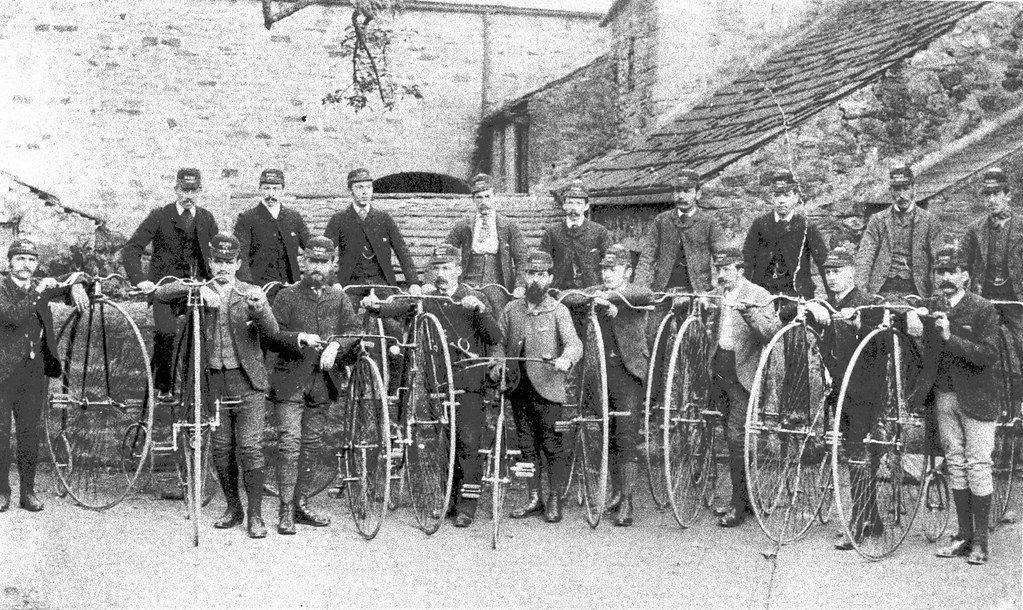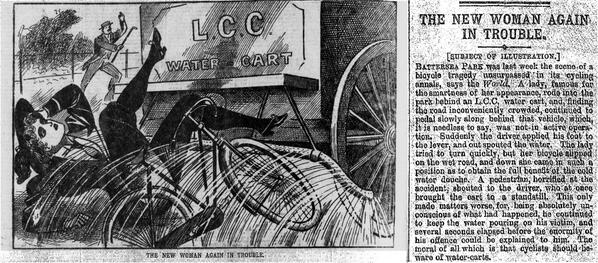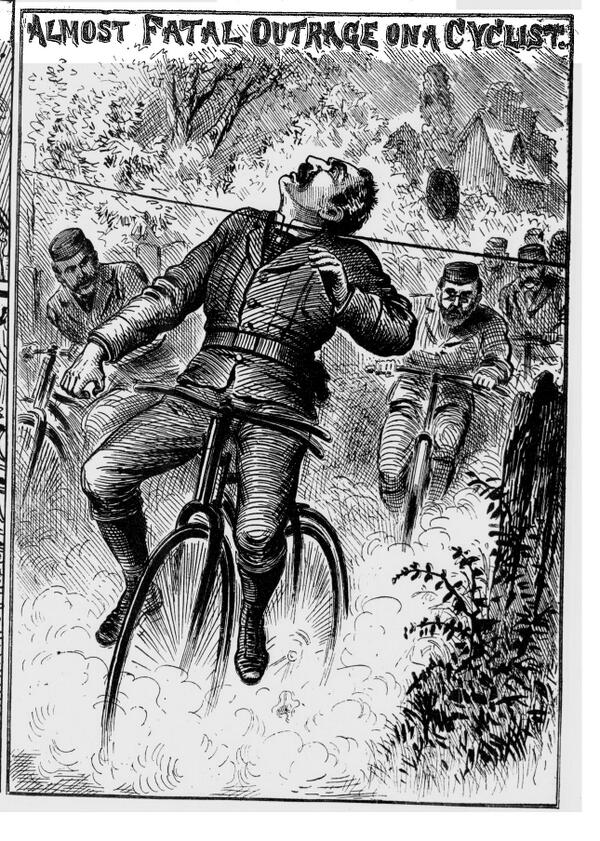
There is an undeniable air of ‘the hipster’ in photos such as the one above. To own a bicycle, have slightly avant-garde facial hair, and wear vintage clothing, are all key ingredients if (as a man- two will suffice for women), you want to claim membership of that ever-expanding modern tribe which is ‘hipsterdom’.
For those who are unfamiliar with the hipster and his or her ways, let me try to briefly explain. Perhaps the best starting point is the recently published ‘Ladybird book of the hipster’ which provides the following definition and illustration:

After living in Leeds for a while I have built up an understanding (primarily through observation rather than doing), that to be hipster is to wherever possible, reject mainstream culture in favour of more organic, vintage and bearded alternatives. You don’t drive a car, you pedal a bicycle. You don’t grow and groom stubble, but rather nurture a moustache which you can twiddle the ends of. For some reason unbeknown to me, you drink coffee out of a glass instead of a mug.
As was first mentioned, you don’t have to look far if you want to find parallels between 1890s men on bicycles and your modern day hipster. If the individual pictured below suddenly appeared in an organic cafe in Shoreditch, I doubt that few, if any eyelids would be batted. This (to me at least) raises the question: to what extent can we claim 1890s male cyclists as the forefathers of modern-day hipsterdom?

Unfortunately, when exploring this assertion in greater detail, a number of problems quickly emerge. Whilst male cyclists during the 1890s often styled fantastic facial hair, this was not a rejection of mainstream culture, but rather an attempt to conform to it. The same is true of the bicycles they owned and the clothes they wore. By the standards of their day, these were certainly not ‘vintage’ or ‘alternative’ but rather emphatically ‘modern’.
However, amongst 1890s cyclists there was a group who, perhaps more than most, held values which are also found at the heart of hipsterdom today. To provide some context: after the invention of the safety bicycle and pneumatic tyre in the mid-to-late 1880s, old fashioned ‘ordinary’ bicycles (which we would also recognise as ‘penny farthings’) slowly became obsolete. Safeties fitted with pneumatic tyres were cheaper to buy, required less energy to pedal, were far more comfortable to ride, and as suggested by the name, were far less dangerous to their user than ordinaries. Looking back on the 1870s from the vantage point of the 1890s, a member of the Bristol Bicycle and Tricycle Club commented,
‘The cycler of these days risked his neck, with the other parts of his anatomy, on what, in appearance at least, was a pair of cart wheels connected by a pump handle. On this fearful contrivance he ventured forth into the country, at that time, practically a terra icognita to the ordinary town resident.’

However there were groups of cyclists who, in true hipster spirit, steadfastly rejected modern, mainstream safeties in favour of their more alternative and vintage ordinary cousins. Their reasons for doing so I am sure will tug on the heart-strings of anyone reading this who still buys and listens to vinyl, or owns a film camera and develops their own pictures. Sure ‘safeties’ were far more user friendly than ordinaries and, by nearly all conceivable standards, represented a technological improvement. However, as was pointed out by a dissident few, the process of riding an ordinary, which required you sit above your huge front wheel with a stiff straight back, had an aesthetic elegance and gracefulness which the modern ‘safety’ could not hope to match. As a correspondent to Cycling stated,
‘As far as looks go I am sure the public would rather see a group of graceful ordinary riders than a group of men rushing along cramped up on their machines, and more resembling monkeys than cyclers.’

A graceful ordinary rider
Moreover, the difficulties which accompanied ordinary riding; namely the serious health risks of falling off, could (with a little imagination) be presented as endearing positives rather than life-threatening negatives. Another correspondent’s letter to Cycling, published in 1891, described how,
‘Thirteen years ago, when I first conceived the idea of taking refuge ennui atop a high wheel, there was some appearance of justification for a young man’s aspiration to master the stately, tall machines then in vogue, as to do so certainly required one to face violence and risk sudden death-two considerations dear to the typical Britain, and essential conditions to the favourable reception by him of any new form of athletic sport.
So for a time bicycling (as we do not understand it now-a-days) flourished, and every Saturday afternoon it was a pretty sight to see the thousands of bicyclists on their graceful tall machines, riding outward from London on every main road.’

A cycling club with their ‘graceful, tall machines’. Source: collections.beamish.org.uk
Building up a head-of-steam, the writer went onto argue that,
‘The modern cyclers have degenerated (like the rest of humanity) into a race of scuttling, quacking, geared-up-dinner-plate-riding ground-game, who, in their pitiable search for safety, have managed to get a saddle just above the surface of the road, and in their luxurious desire for comfort, have hit upon the marvellous expedient of twisting an inflated German-sausage skin around their apologies for wheels; so that we hear now of such incidents as ‘tyres bursting!’
As wonderfully disdainful as this piece is, is does unfortunately undermine the idea that those men who pedalled ordinaries during the 1890s were late-Victorian incarnations of ‘the hipster’. Rather than being young males who rejected mainstream culture in favour of vintage alternatives, they were instead older men, who resolutely carried on doing things the way they had (until recently) always been done. An article in Cycling from 1895 titled ‘The Veteran’, described how your typical older had just one key weakness, namely,
‘His extravagant regard for the memory of his ordinary. He positively bores with his frequent and prosy recitals of all its virtues, and the marvellous adventures he and it have had together; he paints it now as a golden age that has passed forever, and of which the modern safety scorcher can never hope to taste.’
Rather than being the forefathers of modern day hipstersdom, I would argue that 1890s ordinary cyclists are better understood as individuals who carried the flame for a worldview which, I imagine, has existed as long as human history. To again draw on my own experiences of living in Leeds, it will not be present in the young, tattooed, bearded males who spend time in bars and cafes in the city centre, but can instead be found in those who now frequent darkened pubs and tell anyone who cares to listen that modern day cricketers have ‘nowt on Geoffrey Boycott’. As with those who resolutely stuck to their ordinaries, no amount of reasoning can shake them from their resolute belief that things really were better ‘back in the day’.
(For anyone wanting to see this worldview in action, please follow the link below and listen to Van Morrison’s preamble from 45 seconds onwards- the rest of the song is well worth a listen too! https://www.youtube.com/watch?v=Sxk6Rjg7dOo)






















